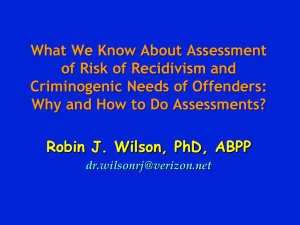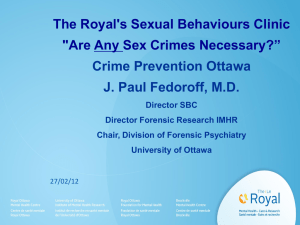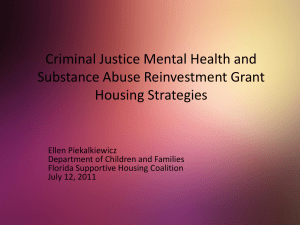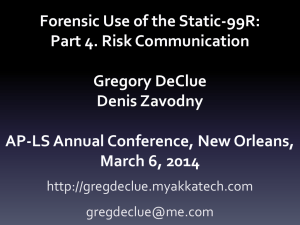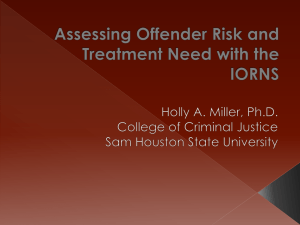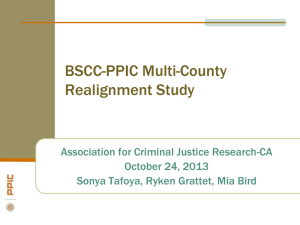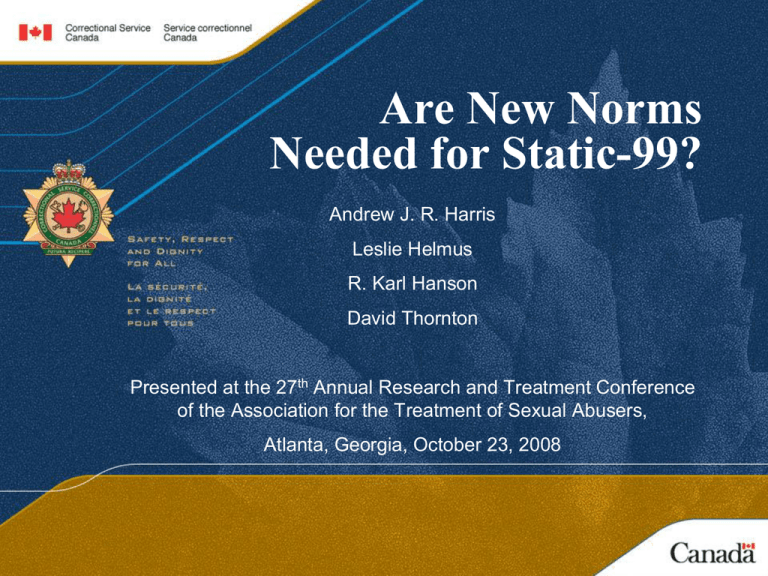
Are New Norms
Needed for Static-99?
Andrew J. R. Harris
Leslie Helmus
R. Karl Hanson
David Thornton
Presented at the 27th Annual Research and Treatment Conference
of the Association for the Treatment of Sexual Abusers,
Atlanta, Georgia, October 23, 2008
Crimes Rates in Canada
12000
10000
8000
Reported
Charged
6000
4000
2000
2006
2004
2002
2000
1998
1996
1994
1992
1990
1988
1986
1984
1982
0
Property Crimes Rates in U.S.:
Uniform Crime Reports
6000
5000
4000
3000
2000
1000
20
06
20
04
20
02
20
00
19
98
19
96
19
94
19
92
19
90
19
88
0
Violent Crimes Rates in U.S.:
Uniform Crime Reports
800
700
600
500
400
300
200
100
20
06
20
04
20
02
20
00
19
98
19
96
19
94
19
92
19
90
19
88
0
Victimization Rates in U.S.: Property
600
500
400
300
200
100
19
73
19
76
19
79
19
82
19
85
19
88
19
91
19
94
19
97
20
00
20
03
20
06
0
2005
2003
2001
1999
1997
1995
1993
1991
1989
1987
1985
1983
1981
1979
1977
1975
1973
Victimization Rates in U.S.: Violent
60
50
40
30
20
10
0
Child Sexual Abuse
• 1990-2004, sexual abuse substantiations
down 49% (Finkelhor & Jones, 2006)
• At least two self-report victimization surveys
with children show decreases in sexual
victimization in the 1990s (Jones & Finkelhor,
2003)
Minnesota Dept of Corrections (2007)
Three-Year Sexual Recidivism Rates
20
18
16
14
12
10
8
6
4
2
0
15
)
(3
02
)
20
02
(3
12
)
20
00
19
98
(3
46
)
19
96
(2
25
)
(2
56
)
19
94
(2
19
92
19
90
(1
26
)
Arrest
Conviction
Incarceration
Are the Original Static-99
Recidivism Estimates
Still Valid???
Static-99
• Actuarial
• Designed to predict sexual and violent recidivism in
adult male sexual offenders
• Includes sexual and violent recidivism estimates (5, 10,
15 years)
• Most widely used in Canada and US
• Archer et al., 2006; Interstate Commission for Adult Offender
Supervision, 2007; Jackson & Hess, 2007; McGrath,
Cumming, & Burchard, 2003
Static-99: Replications
• Most researched instrument for sex offenders (Hanson &
Morton-Bourgon, 2007; Hanson & Morton-Bourgon, in
press)
• Moderate predictive accuracy: ROC = .68; d = .67
• 63 replications
• RRASOR has 34 replications, all other sex offender
tools have < 12
Stability of Static-99
Recidivism Rates
• Doren (2004)
• 5 years; 7 studies
• Helmus (2007/2008)
• 5 & 10 years; 8 samples, n = 3,034
STATIC-99 5-year Sexual Recidivism Rates
(Doren, 2004)
45
40
35
30
Predicted
25
20
Observed (7
studies)
15
10
5
0
0
1
2
3
4
5
6+
STATIC-99 5-year Sexual Recidivism Rates
(Helmus et al., 2007/2008)
45
40
35
30
25
Predicted
Observed
20
15
10
5
0
0
1
2
3
4
5
6+
The Present Project
• Collected datasets with Static-99 scores and recidivism
information
• 26 datasets (so far!)
• All 8 included in Helmus (2008)
• Four from Doren (2004)
• 18 datasets have been transformed, cleaned, and merged
• 1 dataset has violent recidivism only (not sexual)
Studies included
(*cleaned and merged so far)
*Allan et al. (2007) [Kia
Marama]
*Cortoni & Nunes (2007)
Craig et al. (2006)
*Bartosh et al. (2003)
Craissati et al. (2008)
*Bengtson & Långström (2007)
*Bigras (2007)
*de Vogel et al. (2008)
*Eher et al. (2008)
*Boer (2003)
Endrass et al. (in press)
*Bonta & Yessine (2005)
*Epperson (2003)
Studies included
(*cleaned and merged so far)
*Haag (2005)
*Långström (2004)
*Hanson et al. (2007)
*Langton (2003)
*Harkins & Beech (2007)
*Saum (2007)
*Harris et al. (2003)
Wilson, Cortoni, & Vermani
(2007)
Hill et al. (2008)
Johansen (2007)
*Knight & Thornton (2007)
Wilson, Picheca, & Prinzo
(2007)
Wilson, Leaver, & Whealy
(2007)
Descriptives of 18 Samples
• Country:
•
•
•
•
•
8 Canadian (n = 2,271)
4 continental Europe (n = 2,416)
4 U.S. (n = 1,028)
1 New Zealand (n = 493)
1 U.K. (n = 198)
• Offender Type (n = 4,953, Info on 10 samples):
•
•
•
•
53% Child Molester
38% Rapist
5% Other (e.g., exhibitionist, voyeur)
4% Mixed
• Year of Release (n = 6,114, Info on 16 samples):
• 90% released in 1990 or later
Descriptives of 18 samples
• Recidivism Criteria
• 10 samples used charges (n = 3,462); 8 convictions (n = 3,312)
• Location (Info on 16 samples)
• 15 samples from institutions (n = 5,590)
• 3 samples had some community-only offenders (n = 483)
• Sample Type (Info on 12 samples)
• 6 samples pre-selected to be high risk (n = 1,562)
• 5 samples of routine CSC cases (n = 1,249)
• 2 samples with low-risk community cases (n = 477)
• Treatment Status by sample (Info on 9 samples)
• 6 samples mostly treated (75%+, n = 1,414)
• 3 samples mixed (25%-75%, n = 843)
• 0 samples mostly untreated (<25% treated)
Descriptives of 18 samples: Recidivism Info
• Survival Analysis & Cox Regression
• Sexual Recidivism (k = 17, n = 6,406)
• Violent Recidivism (k = 14, n = 6,098)
• Fixed Follow-Up & Logistic Regression
• 5-year Sexual Recidivism (k = 17, n = 4,291)
• 10-year Sexual Recidivism (k = 10, n = 1,621)
• 5-year Violent Recidivism (k = 14, n = 3,929)
• 10-year Violent Recidivism (k = 9, n = 1,642)
New Recidivism Rates: 5-year Sexual
Survival Analysis, initial n = 6,406
45
40
35
30
25
Original
2008 results
20
15
10
5
0
0
1
2
3
4*
5*
6+*
New Recidivism Rates: 10-year Sexual
Survival Analysis, initial n = 6,406
50
45
40
35
30
Original
2008 results
25
20
15
10
5
0
0
1
2
3
4*
5
6+
New 5-Year Sexual Recidivism Rates:
Logistic Regression, n = 4,291
70
60
50
40
Original
2008 results
30
20
10
0
0
1
2
3*
4*
5*
6*
7*
8*
9* 10
10 Year Sexual Recidivism Rates:
Logistic Regression, n = 1,621
70
60
50
40
Original
2008 results
30
20
10
0
0
1
2
3
4
5
6
7
8
9
10
New 5 Year Violent Recidivism Rates
Survival Analysis, initial n = 6,096
50
45
40
35
30
Original
2008 results
25
20
15
10
5
0
0
1
2
3
4
5
6+
10 Year Violent Recidivism Rates:
Survival Analysis, initial n = 6,096
60
50
40
Original
2008 results
30
20
10
0
0
1
2
3
4
5
6+
Did Violent Recidivism Rates Decrease?
• Overall: do not appear lower than original
• Possibilities:
• Sexual recidivism declined but violent did not (unlikely)
• Both declined, but moderators are suppressing
differences
• Most likely: More rapists (37%) than original (28%)
• Let’s look a little closer……
5 Year Violent Recidivism: Child Molesters
(Survival Analysis)
40
35
30
25
Original (n = 662)
2008 (n = 2,507)
20
15
10
5
0
0
1
2
3
4
5
6+
10 Year Violent Recidivism: Child Molesters
(Survival Analysis)
50
45
40
35
30
Original (n = 662)
2008 (n = 2,507)
25
20
15
10
5
0
0
1
2
3
4
5
6+
5 Year Violent Recidivism Rates: Rapists
(Survival Analysis)
60
50
40
Original (n = 276)
2008 (n = 1,747)
30
20
10
0
0
1
2
3
4
5
6+
10 Year Violent Recidivism: Rapists
(Survival Analysis)
70
60
50
40
Original (n = 276)
2008 (n = 1,747)
30
20
10
0
0
1
2
3
4
5
6+
Are Recidivism Rates Declining?
Another approach
• Survival Analysis: Overall comparison of original versus
2008
• Sexual Recidivism
• Original norms: Static-99 M = 3.03, n = 1,086
• 2008 data: Static-99 M = 3.06, n = 6,406
• Overall survival curves significantly different, Wilcoxon (Gehan)
Statistic = 66.5 (df = 1), p < .001
• Violent Recidivism
• Original norms: Static-99 M = 3.03, n = 1,086
• 2008 data: Static-99 M = 3.04, n = 6,098
• Overall survival curves significantly different, Wilcoxon (Gehan)
Statistic = 11.1 (df = 1), p = .001
Are Recidivism Rates Declining?
Overall Survival (Sexual Recidivism)
Are Recidivism Rates Declining?
Overall Survival (Violent Recidivism)
Are Recidivism Rates Declining?
Another Approach
• 2008 data: Logistic Regression for year of release
• After controlling for Static-99 scores, recidivism rates
significantly decline for more recent releases:
• 5 year sexual recidivism (Exp(B) = .965, n = 3,664)
• 10 year sexual recidivism (Exp(B) = .937, n = 1,251)
• 5 year violent recidivism overall (Exp(B) = .967, n = 3,470)
– Also for child molesters (Exp(B) = .953, n = 1,317)
– Trend for rapists (Exp(B) = .970, p = .084, n = 949)
• 10 year violent recidivism (Exp(B) = .941, n = 1,262)
Are Recidivism Rates Declining?
Another Approach
• Cox Regression: Sexual Recidivism
• Significant effect for original versus 2008 data
• rate ratios: average recidivism rate of 2008 data approx. 2/3 of
original, Exp(B) = .656, n = 7,492
• When control for Static-99 scores, effect gets slightly
larger
• Exp(B) = .592, n = 7,492
Are Recidivism Rates Declining?
Another Approach
• Cox Regression: Violent Recidivism
• Significant effect for original versus 2008 data (though
smaller than for sexual)
• Exp(B) = .872, n = 7,184
• When control for Static-99 scores, effect gets slightly
larger
• Exp(B) = .828, n = 7,184
• When control for Static-99 AND rapist/child molester,
effect of original versus 2008 increases
• Exp(B) = .728, n = 5,192
• Rapist/child molester suppressing differences between
original and 2008 findings
Are Recidivism Rates Declining?
Summary
• Sexual Recidivism
• Significant differences in both low power and high
power tests
• Differences meaningful
• e.g., survival analysis, scores of 6+
• 39% versus 26% at five years
• 45% versus 35% at 10 years
Are Recidivism Rates Declining?
Summary
• Violent Recidivism
• Appear similar
• Low power tests: no differences
• High power tests: significant differences
• Conclusion: Violent recidivism lower in 2008 samples,
but suppressed by increased proportion of rapists
Are New Norms Needed for Static-99??
• Yes
• Sexual and violent recidivism have declined since original
norms were developed
• Newer norms should be used
NEXT: What about moderators? Are separate recidivism
tables needed?
Moderators: Using Cox Regression
• Sample Type
• Pre-selected high risk
• Bridgewater, Denmark Psychiatric, CSC Detained, Dutch
Psychiatric, Penetanguishene, Canada NFS/DO/Detained
• Routine CSC
• Dynamic Supervision Project federal cases, B.C., Quebec,
Warkworth, National Sexual Offender Treatment Program
• Rapist/Child molester
• Insufficient cases to look at treatment variables
• Have not yet looked at jurisdiction
Moderators: Sexual Recidivism
Cox Regression
• After controlling for Static-99, pre-selected high risk
samples (n = 1,273) showed higher sexual recidivism
rates than routine CSC samples (n = 1,249), Exp(B) =
2.414
• Possible interaction between Static-99 score and high
risk/routine CSC distinction
• Possible that Static-99 predicts better in routine CSC
samples (high risk groups are showing high recidivism
rates in low risk categories)
• Separate tables NOT needed for rapists/child molesters
10 Year Sexual Recidivism Rates
(from logistic regression estimates)
70
60
50
40
High Risk (n = 735)
30
CSC (n = 342)
20
10
0
0
1
2
3
4
5
6
7
8
9
10
10 Year Sexual Recidivism Rates
(from logistic regression estimates)
70
60
50
40
High Risk
CSC
Original
30
20
10
0
0
1
2
3
4
5
6
7
8
9 10
10 Year Sexual Recidivism Rates
(from logistic regression estimates)
70
60
50
Rapist (n = 360)
40
Child Molesters (n
= 544)
30
20
10
0
0
1
2
3
4
5
6
7
8
9 10
Moderators: Violent Recidivism
Cox Regression
• After controlling for Static-99:
• Pre-Selected High Risk samples (n = 1,241) showed
higher violent recidivism rates than routine CSC
samples (n = 1,249), Exp(B) = 1.858
• Child molesters (n = 2,507) showed lower violent
recidivism rates than rapists (n = 1,749), Exp(B) = .618
• Interaction between rapist/child molester and highrisk/CSC (N = 1,309, p = .002)
• CSC/pre-selected high risk distinction matters less for rapists
5 Year Violent Recidivism Rates
(from logistic regression estimates)
80
70
60
50
High Risk (n =
1,110)
Routine CSC (n =
752)
40
30
20
10
0
0
1
2
3
4
5
6
7
8
9
10
5 Year Violent Recidivism Rates
(from logistic regression estimates)
80
70
60
50
Rapist (n = 1,107)
40
Child Molesters (n
= 1,539)
30
20
10
0
0
1
2
3
4
5
6
7
8
9 10
This project is exciting. Is it too late to contribute my data for
this research??
Not at all!
If you have any Static-99 data that you are willing to consider
sharing for this important project, or if you would like
further information about this project, please contact:
Leslie Helmus
leslie.helmus@ps.gc.ca
613-998-0312
Note: This research is not yet complete!!!
Wouldn’t it be nice if there was a website where I could
obtain the new recidivism norms once they become
available??
Now there is! For updates, please check:
www.static99.org

